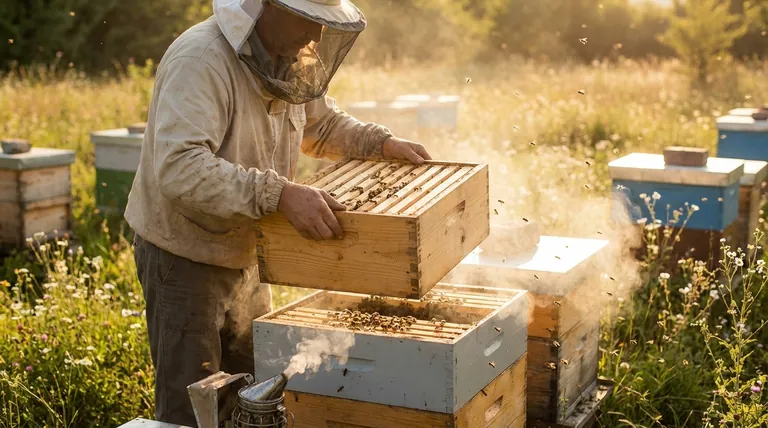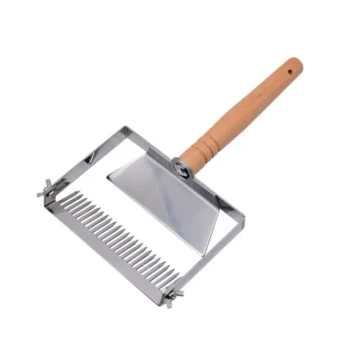Hive congestion is a critical signal that your colony is running out of physical space. This lack of room directly threatens the hive's productivity, internal ventilation, and overall health. Adding a super is the essential management action to alleviate this pressure, providing the necessary space for the colony to expand, store resources, and function efficiently.
A crowded hive is not just a sign of success; it's a direct warning that the colony's natural impulse is shifting from honey production to swarming. Adding a super is your primary tool to redirect that energy back toward growth and storage.

The Core Problem: Stifled Growth and Swarm Impulse
A honeybee colony is a superorganism driven by a single imperative: expansion. When its physical space becomes limited, several critical functions begin to break down, creating a cascade of problems that ultimately threaten the beekeeper's goals.
The Queen Runs Out of Room
A healthy queen can lay over 1,500 eggs per day. She requires empty, polished cells to do this.
When frames become clogged with honey, pollen, and bees, the queen has no space to lay. This "brood-bound" condition halts the production of new workers, leading to a future decline in the colony's population and foraging power.
Nectar and Pollen Have Nowhere to Go
Forager bees returning to the hive with nectar need a place to deposit it for processing.
If all available cells are full, foragers are forced to wait, creating a "traffic jam" in the hive. This bottleneck drastically reduces foraging efficiency and can cause the colony to stop gathering resources altogether, even during a strong nectar flow.
Poor Air Circulation and Temperature Control
A congested hive is difficult to ventilate. The sheer mass of bees impedes the flow of air they create by fanning their wings.
This leads to increased humidity and difficulty in regulating the hive's internal temperature. Poor ventilation makes it harder to cure nectar into honey and can create an environment ripe for diseases like chalkbrood.
Understanding the Ultimate Consequence: The Swarm
The most significant consequence of unmanaged hive congestion is swarming. While a natural part of bee reproduction, it is highly detrimental to honey production and hive management.
What Triggers the Swarm Instinct?
Congestion is the primary trigger for swarming. When the bees perceive that the hive is full and the queen is running out of laying space, they instinctively begin preparations to split the colony.
How Congestion Leads to Swarming
The crowded conditions dilute the circulation of the queen's pheromones, which normally suppress the workers' instinct to raise new queens. In response, workers begin constructing special "swarm cells" to raise new queens.
Just before these new queens emerge, the original queen will leave the hive with up to half of the workforce, forming a swarm to find a new home.
Why Swarming is Detrimental
For the beekeeper, a swarm represents a significant loss. You instantly lose half of your bees and your established, productive queen. The remaining colony must focus its energy on raising and mating a new queen, leading to a major slump in population growth and honey production for several weeks.
How Adding a Super Solves These Problems
Adding a new box (a "super") on top of the existing hive is a direct and effective solution to the problems caused by congestion.
Restoring Space for Expansion
The new super provides immediate, empty real estate. This gives the bees a place to build new comb and, most importantly, store incoming nectar.
By moving honey stores up into the super, the bees free up cells in the brood boxes below, giving the queen essential room to lay eggs and maintain the colony's population.
Providing Critical Storage for Resources
With ample storage space available in the super, forager bees can offload nectar quickly and efficiently. This re-starts the colony's production engine, allowing them to take full advantage of a nectar flow.
Suppressing the Swarm Impulse
Providing new space is the clearest signal you can send to a colony that it does not need to swarm. It alleviates the primary trigger—congestion—and convinces the bees that they can continue to expand where they are. This redirects their energy back to building comb and storing honey.
Common Pitfalls to Avoid
Timing is everything. Acting too early or too late can create different sets of problems.
Adding a Super Too Early
If you add a super to a colony that is not yet strong enough to occupy it, you create a large, empty space that the bees cannot effectively patrol or keep warm.
This makes the hive vulnerable to pests like wax moths and small hive beetles. It also forces the colony to expend extra energy on temperature regulation instead of growth. A good rule of thumb is to wait until the bees are using 7 or 8 of the 10 frames in their top box.
Adding a Super Too Late
If you wait until you see swarm cells with larvae in them, you may already be too late. Once the swarm impulse is fully engaged, simply adding a super is often not enough to prevent the colony from splitting. At this point, more advanced swarm management techniques are required.
Making the Right Call for Your Goal
Your decision on when to add a super should be guided by your primary objective for the hive.
- If your primary focus is maximizing honey production: Add a super when the top box is 70-80% full to ensure foragers never stop collecting nectar during a flow.
- If your primary focus is swarm prevention: Add a super as soon as you see bees filling the space between the outer frames and the hive wall to preemptively manage the swarm instinct.
- If your primary focus is supporting a new or weak colony: Wait until the bees have fully drawn out and are using all frames in their current box to avoid giving them more space than they can defend.
By reading the signs of congestion and acting decisively, you shift from simply keeping bees to actively managing a thriving, productive colony.
Summary Table:
| Problem Caused by Congestion | How Adding a Super Solves It |
|---|---|
| Swarm Instinct Triggered | Provides space, signaling the colony to expand, not swarm. |
| Queen Runs Out of Laying Space | Frees up brood cells by moving honey stores upward. |
| Foraging Bottlenecks & Stopped Production | Creates immediate storage for nectar, restarting the production engine. |
| Poor Ventilation & Disease Risk | Reduces bee density, improving air circulation and hive health. |
Ready to Manage a Thriving, Productive Apiary?
Hive congestion is a critical management point. Equip your operation with the right supplies to act decisively. HONESTBEE supplies commercial apiaries and beekeeping equipment distributors with the high-quality supers, frames, and foundation needed to support colony growth and maximize honey yields.
Let's discuss your wholesale needs: Contact our team today to ensure you have the equipment to keep your colonies productive and swarm-free.
Visual Guide

Related Products
- In-Hive Dual Compartment Frame Bee Feeder for Targeted Colony Nutrition
- HONESTBEE Professional Entrance Bee Feeder Hive Nutrition Solution
- Wooden Bee Brush with Double-Row Horsehair Bristles
- Boardman Entrance Bee Feeder Durable Galvanized Steel and Wood Construction for Beekeeping
- Plastic Handle Single Row Artificial Fiber Bee Brush
People Also Ask
- What is a frame feeder? A High-Capacity, Secure In-Hive Feeding Solution
- What are frame feeders, and what are their advantages? Essential for Cold Weather & Efficient Feeding
- When is sugar syrup typically fed to bees? A Guide to Strategic Feeding for Strong Hives
- How do you feed bees outside the hive? Understanding the Risks and Safe Alternatives
- What are division board feeders? Essential Tools for Safe and Effective In-Hive Feeding



















